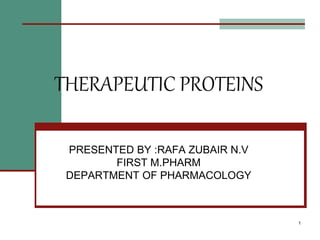Therapeutic proteins are proteins engineered for pharmaceutical use. They are produced through recombinant DNA technology and delivered to replace proteins deficient in certain illnesses. Therapeutic proteins are classified based on their pharmacological action, molecular type, and mechanism. They can be produced through microbial bioreactors, mammalian cell culture bioreactors, or by expressing the protein in the milk of transgenic animals. Common therapeutic proteins include hormones, clotting factors, vaccines, and monoclonal antibodies used to treat diseases like cancer, infections, hemophilia, and hepatitis.



























